Double-door/pass-through autoclaves Systec H-Series 2D
The new generation Systec H-Series 2D double-door/pass-through autoclaves of the performance category HX can be used for all laboratory applications, even for sophisticated sterilization processes and are available in 13 different sizes with 90 to 1580 liters chamber volume. The combination of new features guarantees higher work precision, easier maintenance of devices, shorter and more efficient process times. All additional optional accessories can be fitted to obtain validatable processes. For use under the most stringent clean room and safety conditions: For biological safety laboratories, e.g. fitting as a sterilization and pass-through lock for protecting the external environment, for clean rooms in laboratories and production facilities as a sterilization and pass-through lock separating sterile and non-sterile areas.
AVAILABLE WITH FOUR CHAMBER DIAMETER: 400 MM, 500 MM, 740 MM and 1000 MM
Systec HX
For all laboratory applications even for sophisticated state-of-the-art sterilization processes. With all possibilities to add additional options for process optimization to enable validatable sterilization to be carried out.
Dimensions and performance
Chamber dimensions Ø x depth (mm)
Chamber volume in liters total / nominal
Systec HX-90 2D
400 x 750
100 / 90
Systec HX-150 2D
500 x 750
160 / 150
Systec HX-200 2D
500 x 1000
210 / 200
Systec HX-320 2D
740 x 750
370 / 320
Systec HX-430 2D
740 x 1000
480 / 430
Systec HX-540 2D
740 x 1250
590 / 540
Systec HX-650 2D
740 x 1500
700 / 650
Systec HX-580 2D
1000 x 750
680 / 580
Systec HX-780 2D
1000 x 1000
880 / 780
Systec HX-980 2D
1000 x 1250
1075 / 980
Systec HX-1180 2D
1000 x 1500
1270 / 1180
Systec HX-1380 2D
1000 x 1750
1465 / 1380
Systec HX-1580 2D
1000 x 2000
1665 / 1580
Electrical connections for:
Systec HX-90 2D to Systec HX-200 2D: 380 – 400 V, 50 / 60 Hz, 16 A.
Systec HX-320 2D to Systec HX-650 2D: 380 – 400 V, 50 / 60 Hz, 32 A.
Systec HX-580 2D to Systec HX-1580 2D: 380 – 400 V, 50 / 60 Hz, 63 A.
Different voltage available upon request.
Standard Features
hxSystec hx
Integrated steam generator separated from the chamber
Housing, support frame and pressure chamber, made of corrosion-resistant stainless steel
Temperature and pressure range 140 °C, 4 bar absolute pressure
The pressure vessel of the autoclave is made of corrosion-resistant stainless steel 1.4404 (AISI 316L)
All connections on the pressure vessel are designed as Tri-Clamp
Touch screen control
Number of sterilization programs (up to 100)
Code-secured access rights for changing parameters and further safety-relevant intervention
Internal memory capacity for storing up to 10 years of data backups
Timer for programmable start time
Flexible PT-100 temperature sensor (class A)
Additional temperature sensor in condensate exhaust
Special program for Durham tubes
Calculation of F0 value
Special program for destructive sterilization with fractional heating for more efficient venting
Waste water temperature is water-cooled and thermostatically controlled
Adjustable automatic opening of door at end of program
Network and USB ports for external data transfer
Text input for batch information (up to 20 characters)
User account control (standard). The standard user account control has three permanently pre-configured and fixed user groups, each with one available user (Administrator, Operator or Supervisor).
Validation port for introducing measuring equipment
Integrated feature for comprehensive batch documentation, with export as PDF and CSV
Time synchronization with time server via network or internet
Available options
Extension of temperature and pressure ranges to 150 °C / 5 bar absolute pressure
All fittings and valves in the supply lines (from media connection to sterilization chamber) for demineralized water, steam or compressed air are made of stainless steel. All piping is made of FDA-certified PTFE.
Keep-warm function for liquids after program has finished
Potential-free contact: It can be used to establish an external potential-free connection to one or more digital outputs or device status lines.
Combined heating: The combined heating function supplements the built-in steam generator with an external steam heating option
External steam supply: connection to an external steam source (house steam)
Additional programs: such as hydrolitic resistance of glassware*, rubber-closure test**, ramp programs, material test programs
Feature for the integration into LIMS and SCADA systems via OPC UA
Up to 5 additional PT-100 temperature sensors
Options for process optimization
Rapid cooling for efficient and safe cooling of liquids
Radial ventilator and Ultracooler to speed up the cooling process
Spray heating and / or spray cooling for fast heating and cooling of liquids
Steam-air mixture method: Support pressure during the heating, sterilization and cooling phases. Particularly suitable for vessels which are at risk of bursting or deformation, and for sealed vessels.
Vacuum system to carry out the validated sterilization of solids and wastes in disposal bags
Superdry for drying solids (only in combination with optional vacuum system)
Exhaust air filtration (including condensate deactivation) for safe sterilization of hazardous biological substances
Options for documentation
Integrated printer for batch documentation
Save to Folder. Automatic data transfer via FTP/SFTP
Enhanced user account control: Up to 100 user and 100 groups can be configured and administered
Advanced CFR 21 Part 11 solution including AuditTrail. Enables run data to be electronically signed (so that it is tamper-proof). Documentation of all changes to the device and all alarm messages.
Personalized certificates for electronic signatures of run data (only applicable with the extended user account control)
*According to EP 3.2.1 and USP
**According to EP 3.2.9 and USP
Systec autoclaves are delivered ready for subsequent installation of all options.
Further options and special programs as well as baskets and inserts, transport and loading systems on request.
For further information on options and accessories please click on "Options".
-
Design
State-of-the-art engineering
Systec autoclaves ensuring a high quality of laboratory sterilization processes.
Diameter 1000mm 
Diameter 740mm Available with four chamber diameter
Available with four chamber diameter: 400 mm, 500 mm, 740 mm and 1000 mm. 1000 mm diameter chamber provides the usable chamber dimension of a 6 x 6 square chamber autoclave.All-round quality
The sterilization chamber is not only made of robust and corrosion-resistant 316L stainless steel (1.4404), it has also been electropolished and is therefore particularly easy to clean. In addition, all connections on the chamber are designed as tri-clamps. The housing trim and the support frame are made of stainless steel as well. The high-quality Hanno-Tect insulation prevents the separation of particles, allowing Systec autoclaves to be used reliably under clean-room conditions.Dual sensors
Systec H-Series autoclaves include both a flexible temperature sensor (PT-100) and an integrated pressure sensor. The PT-100 sensor can be placed in fluids to provide a reference point. In addition, the Systec H-Series also feature a second temperature sensor. This one is located in the floor drain.Triple safety aspects:
- One door only can be opened at a time. If one door is open, the other is automatically locked.
- If the autoclave is switched off or of no current is available (e.g. power failure), booth doors remains locked.
- If the door at the non-sterile side is opened, a sterilization program hast to be performed before the door at the sterile side can be opened.
For use under the most stringent clean room and safety conditions:
- For biological safety laboratories. Fitting as a sterilization an pass-through lock for protecting the external environment.
- For clean rooms in laboratories and production facilities as a sterilization and pass-through lock separating sterile and non-sterile areas.
Systec autoclaves are fitted with the following connections at the rear:
HX Demineralized water inlet for steam generation – Compressed air (Systec HX-65 to HX-200) – Compressed air (Systec HX-210 to HX-1580) – Cooling water – Common outlet – Network /USB – Flexible cord with CEE plug – Connection to cooling circuit (Systec HX-65 to HX-200) – Connection to cooling circuit (Systec HX-210 to HX-1580) – – = Standard– = Optional
All according to norms and regulations
Systec H-Series autoclaves are specifically designed to withstand higher temperatures and pressure ranges. With their advanced pressure vessels, these autoclaves can operate at temperatures of up to 170 °C and pressures of up to 5 bar (absolute pressure). To retrofit older models, control and safety components can be adapted to higher temperatures and pressures via optional pressure and temperature extension accessories. -
Steam generation
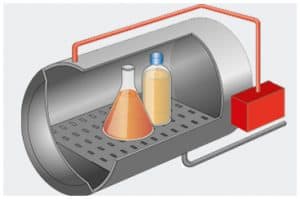
Steam generator Steam generation by steam generator HX
A separate steam generator is incorporated in the housing.This has numerous advantages:
- No heating elements and no reservoir for dirty water in the chamber.
- In conjunction with the stand-by pre-heating function, only 10 min. heating time to 121 °C with an empty chamber is required.
- Improved air removal by suppressing the air to the bottom with its natural gravitation.
- Quicker cooling as neither the hot water in the chamber nor the separate steam generator need to be cooled.
- After cooling, steam is immediately available for the next sterilization run.
Condensation of steam instead of removal HX
Exhaust steam is condensed automatically via a PT-100-regulated cooling system. This prevents odors and protects waste water piping that may be made of plastic. -
Operation

Touch-screen Touch-Screen technology
The autoclave is operated quickly and easily via a 5.7-inch, perfectly legible touch display. This offers a high degree of flexibility and many options when using the laboratory autoclave. For example, all data relevant to the process can be displayed both numerically and graphically. Also, 5 helpful programs are already predefined. The user also has the option of creating, changing or deleting up to 100 programs himself. To make the creation of new programs particularly easy for the user, he is guided through the entire process in an easy-to-understand dialog. Newly created programs are automatically assigned a fixed identifier, though an individual name can be chosen as well. The process parameters can be changed as desired.Pre-defined programs
1 Solids
2 Waste bags
3 Liquid waste
4 Liquids
5 Cleaning
6 Vacuum test*
7 Bowie-Dick test*These can be expanded to 100 sterilization programs.
* Only in combination with a vacuum device. -
Safety
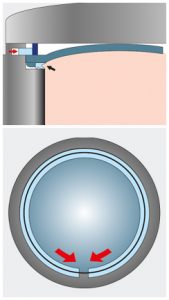
Door locked Automatic closing and opening system
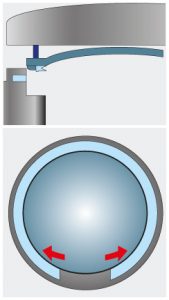
Door open Safe and smooth-running – a circumferential locking ring automatically closes the door of the autoclave after it is pressed down. A special heat-resistant silicone lip seal ensures reliable sealing. One highlight of this technology: the higher the pressure inside the sterilization chamber, the tighter the lip seal seals – no additional compressed air or other pressure aides are required. In addition, the quick-release door lock is particularly temperature-resistant in accordance with DIN EN (IEC) 61010-2-040. The door stays locked until all excess pressure has been cleared from the sterilization chamber. This effectively prevents contact with hot parts.
Automatic door system
The door opens automatically at the end of the program. This can happen either automatically or by pressing a button – depending on the selected setting. This self-opening function is extremely useful for the workflow, especially when materials still need to cool down or dry after they have been autoclaved. The residual steam can thus escape without further intervention and without interrupting the work. The residual heat supports rapid drying of the items to be sterilized. The automatic door opening is limited to an angle of about 15°. This means that there is no risk of contamination from the outside. To remove the sterilized materials, the door is then opened further by hand.
-
Standards & regulations
Systec autoclaves comply with the following standards and regulations:
Pressure vessel:
- 2014/68/EU Pressure Equipment Directive
- ASME Boiler & Pressure Vessel Code, Section VIII, Division 1
- China Stamp
Other guidelines:
- 2014 / 35 / EU Low Voltage Directive
- 2014 /30 / EU on Electromagnetic Compatibility
All autoclaves are CE marked.
We will be happy to provide a complete list of standards and summary of regulations on request.
-
 Sterilization load and sterilization process
Sterilization load and sterilization process
Select the right process for every sterilization application
Several options are available that are necessary to obtain correct and validatable results and rapid cooling times. The Options depend on the items to be sterilized. The autoclave can be optimally configured for the necessary tasks.The table below provides help in establishing the desired configuration. Please obtain additional advice from our experts.
Ventilation Cooling Drying Other Gravitation Simplepre-vacuumPulsed excesspressureFractionatedpre-vacuumConventionalcooling withslow pressurereleaseRapid coolingsystem withsupportpressureSurface dryingwithoutvacuumDrying withsubsequentvacuum+ SuperdryExhaust airfiltrationLiquids + ? – – ? + ? – Unpacked non hollow items+ + + + ? + Porous materials (filters, fabrics)– ? ? + + Hollow items (pipette tips,empty glassware, tubesand hoses)– – – + – + Contaminated waste indestruction bags– – ? + – – + + Recommended procedure ? Possibly acceptable – Not possible
-
 Sterilization of liquids
Sterilization of liquids
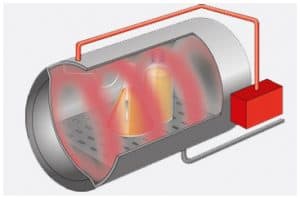
Heating up Heating up
The actual sterilization time of e.g. 15 minutes at 121 °C is only a fraction of the total time involved for an autoclave procedure. Especially in the case of sterilizing liquids, the heating up and cooling down phases are considerably longer.Up to 50 % shorter heat-up times as standard
Due to the combined temperature and pressure regulation, the chamber pressure is increased during the heat-up phase. The result: more rapid temperature equilibrium in the liquids and a shorter heat-up time.
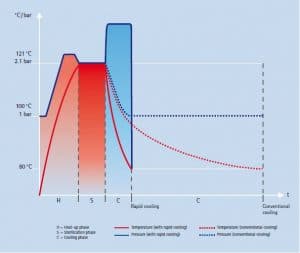
Conventional cooling vs. Rapid cooling Cooling
The cooling process for liquids is also very slow; this is because, without active rapid cooling, the heat can only be reduced to below 100°C by dissipating the heat via the chamber insulation by radiation (see diagram: conventional cooling).
New system- and process technology make it possible to substantially reduce the overall time required for the sterilization process (see diagram: rapid cooling).Systec offers many functions for its autoclaves guaranteeing safe liquid sterilization processes at higher productivity.
In addition to conventional cooling by regulated steam exhaust down to 100 °C and subsequent very slow self-cooling down to 80 °C, optional cooling systems for rapid cooling are available.
- Cooling with ambient air ventilation
- Mantle cooling with cooling water
- Mantle cooling with cooling water and support pressure
- Radial ventilator for air circulation and accelerated heat removal from the chamber
- Ultracooler
- Spray cooling with recirculated and recooled sterile water and support pressure
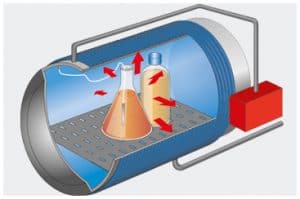
Mantle cooling with cooling water and support pressure Mantle cooling with cooling water and support pressure HX
During the entire sterilization process a flexible PT-100 temperature sensor monitors the temperature in a reference vessel. It is guaranteed that the sterilization period begins only once the sterilization temperature has been attained in the liquid to be sterilized.The cooling temperature is also constantly monitored. In accordance with relevant standards to prevent delayed boiling, the lid can only be opened once the temperature of the liquid has been reduced to at least 80 °C.
The use of support pressure in the form of sterile-filtered compressed air during the cooling phase reliably prevents the culture medium from boiling.
Advantages:
- No loss of liquid due to boiling of the culture media
- Improved productivity from reduced cycle times and the full utilization of the filling volume in each bottle
- Prevention of delayed and over-boiling
- Prevention of the risk of bottles bursting during or after sterilization
- Prevention of re-contamination by the use of hermetically sealed bottles during sterilization
- Reduction of cooling time by up to 60 %
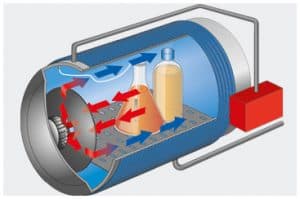
Radial ventilator Radial Ventilator HX
In conjunction with optional mantle cooling with cooling water and support pressure, the radial ventilator ensures accelerated removal of heat from the sterilization items to the cooled chamber mantle.- The radial ventilator is placed in the lid of the chamber so that the usable space in the autoclave is not reduced!
- Ventilation performance 250 m3/h
- Reduction of cooling time by up to 70 %
Ultracooler HX
In conjunction with optional mantle cooling with cooling water, support pressure and radial ventilator, it is possible to significantly reduce the recooling time and the entire sterilization process by integrating of the additional ultracooler heat exchanger.
Ultracooler - The ultracooler is placed in the lid of the chamber near the radial Ventilator. The usable space in the autoclave is not reduced!
- Reduction of cooling time by up to 90 %
- Depending on the load, cooling times between 15 and 60 minutes can be achieved
-
 Sterilization of solids
Sterilization of solids
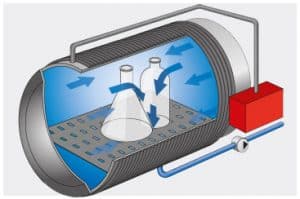
Vacuum system Vacuum system HX
Typical solids are pipette tips (in boxes), empty glassware and waste in bags as wall as porous materials such as filters or fabrics. The vacuum device effectively removes the air from solids, tubing, porous materials, fabrics and disposal bags, allowing the steam to penetrate completely. The process includes a fractionated pre-vacuum phase in combination with the standard steam generator.
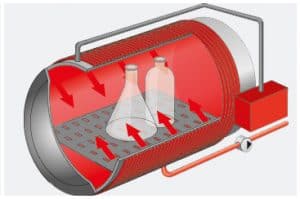
Superdry Superdry – for drying solids HX
This optional accessory increases the drying efficiency for solids and porous materials such as filters and fabrics. Deep-vacuum drying using the optional vacuum device in conjuction with Superdry avoids the necessity for subsequent drying in a separate drying cabinet. -
 Sterilization of waste in disposal bags
Sterilization of waste in disposal bags
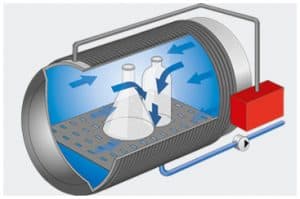
Vacuum system Vacuum system HX
Typical solids are pipette tips (in boxes), empty glassware and waste in bags as wall as porous materials such as filters or fabrics. The vacuum device effectively removes the air from solids, tubing, porous materials, fabrics and disposal bags, allowing the steam to penetrate completely. -
 Sterilization of hazardous biological substances
Sterilization of hazardous biological substances
Exhaust air filtration with condensate inactivation
For the sterilization of hazardous biological substances, Systec autoclaves can be fitted with an optional air exhaust filtration system. The autoclavable sterile filter, consisting of a filter cartridge with PTFE membrane of pore size 0.2 μm, is installed in a presure-proof housing and can be quickly
Exhaust air filtration changed at any time. The filter is also automatically sterilized inline during the sterilization process, monitored by the PT-100 temperature sensor. The condensate is retained inside the pressure vessel during the heating and sterilization phases and thus also sterilized. Through air exhaust filtration and condensate inactivation, it is ensured that no microorganisms can escape before end of the sterilization phase.
-
Additional options
Temperature and pressure ranges extension HX
Possibility to extend the temperature and pressure ranges to 150 °C / 5 bar absolute pressure.
Keep-warm function HX
for liquids after program has finished.
Potential-free contact HX
for establishing an external potential-free connection to one or more digital outputs or device status lines. It helps to prevent malfunctions when switching external actuators (such as valves, signal lamps and pumps).
Combined heating HX
The built-in steam generator can be combined with an external steam heating option.
External heat supply HX
Connection to an external steam source (house steam).
Additional programs HX
such as ramp programs, material test programs, hydrolitic resistance of glassware* and rubber-closure test**.*According to EP 3.2.1 and USP <660>
**According to EP 3.2.9 and USP <381>
Feature for the integration into LIMS and SCADA systems HX
via OPC UA.
Up to 5x PT-100 temperature sensors HX
for the Systec H-Series autoclaves are available additionally. -
Options for documentation
STANDARD: Internal memory HX

Internal memory All process data is reliably stored on a factory-installed internal memory. This internal memory is part of the Systec PLC and provides sufficient capacity to archive the data over a period of about 10 years.
STANDARD: Elektronic data output HX

Electronic data output A documentation feature has been integrated to enable comprehensive batch documentation and the electronic data export in PDF or CSV format (via USB or network interface*). This displays the individual program phases, the process parameters and the program sequence in tabular, graphic and numerical form.
*for data transfer to a server or PC in the network, the interface requires the optional “Save to Folder” feature.
STANDARD: Backup feature HX

Backup feature USB-based backup features allow users to save and restore the following:
- lists of available programs and their parameters
- backup files including the current device software and all of its databases
The backup file is manipulation-protected via software encryption.
STANDARD: Real-time clock HX

Real-time clock The real-time clock built into the device has an automatic time changeover:
- automatic summer and winter time changeover
- automatic recognition of a leap year
The time, time zone and date can be set quickly and easily, either manually, using the touch display or via the webserver. Alternatively, these parameters can be set automatically via the Internet. To set the time automatically, a special time server and an active Internet connection are required.
OPTIONAL: Save to Folder HX

Save to folder After a sterilization cycle has been finished, the “Save to Folder” function exports the logs of the current sterilization process to the customer’s computer or server automatically. This feature supports FTP, SFTP and FTPS server types.
OPTIONAL: SCADA connection HX

Scada connection The autoclave transmits relevant information such as the current values of inputs and outputs (analog or digital) as well as the current process status and alarms via the OPC-UA protocol.
OPTIONAL: Printer HX

Printer An optional printer can be fitted to the autoclaves for documenting information such as batch number, program type, time, and date. Printouts contain all the program cycle’s essential information, such as basic settings as well as the success or failure of a sterilization cycle. The language of the printout can be selected in the menu.
OPTIONAL: Advanced CFR Part 11 solution HX

Advanced CFR 21 Part 11 solution Systec H-Series autoclaves allow for data to be downloaded either as CSV (Microsoft Excel) or PDF files or both* via the USB port or network interface**. The autoclave signs both types of files electronically, making sure the file can be clearly attributed to the particular autoclave. The signature also shows whether the files exported from the autoclave are valid, with any attempt at manipulation automatically marking the file as invalid.
The advanced CFR 21 Part 11 solution also includes:
- Extended control over user accounts, including global or local program lists which show users and user assignment to a group (users, supervisors etc., all with customizable rights and permissions).
- AuditTrail: All actions executed by the autoclave, from changing parameters to running the program, are documented so both the user and the date/time of these actions can be traced back.
- Up to five fields for adding electronic signatures to sign exported PFG or CSV files on any device with the respective electronic signature functionality. The electronic signatures are not included in this option.
* The network interface only allows the transfer of process logs.
** For data transfer to a server or PC in the network, the interface requires the optional “Save to Folder” feature. -
Options for process optimization

Mantle cooling with cooling water and support pressure Mantle cooling with cooling water and support pressure HX
During the entire sterilization process a flexible PT-100 temperature sensor monitors the temperature in a reference vessel. It is guaranteed that the sterilization period begins only once the sterilization temperature has been attained in the liquid to be sterilized. In accordance with relevant standards to prevent delayed boiling, the lid can only be opened once the temperature of the liquid has been reduced to at least 80 °C.

Radial ventilator Radial Ventilator HX
In conjunction with optional mantle cooling with cooling water and support pressure, the radial ventilator ensures accelerated removal of heat from the sterilization items to the cooled chamber mantle.- The radial ventilator is placed in the door of the sterilization chamber so that the usable space in the autoclave is not reduced!
- Ventilation performance 250 m3/h
Ultracooler HX
In conjunction with optional mantle cooling with cooling water, support pressure and radial ventilator, it is possible to significantly reduce the recooling time and the entire sterilization process by integrating of the additional ultracooler heat exchanger.
Ultracooler - The ultracooler is placed in the door of the sterilization chamber near the radial ventilator so that the usable space in the autoclave is not reduced
- Reduction of cooling time by up to 90 %

Superdry Superdry – for drying solids HX
This optional accessory increases the drying efficiency for solids and porous materials such as filters and fabrics. Heat energy from the standard steam generator is transferred to the heating coils around the body of the sterilization chamber and is used for drying. Deep-vacuum drying using the optional vacuum device in conjuction with Superdry avoids the necessity for subsequent drying in a separate drying cabinet.

Vacuum system Vacuum system HX
Typical solids are pipette tips (in boxes), empty glassware and porous materials such as filters or fabrics.The vacuum device effectively removes the air from solids, tubing, porous materials, and fabrics, allowing the steam to penetrate completely. The process includes a fractionated pre-vacuum phase in combination with the standard steam generator.
-
Accessories

Loading baskets and inserts
Stainless steel wire mesh baskets, stackable.
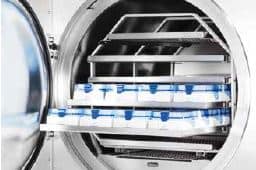
Rack system Rack system
The autoclaves can be fitted with rack systems to fully utilize the available space in the chamber, especially when sterilizing small items.
Transport cart and transfer cart with Easy Load
Large autoclaves in particular can be easily and securely loaded using special transport and transfer carts with Easy Load. The items to be sterilized can either be placed directly on the transfer cart with rails or using a basket. The transport cart can be moved and docked to the autoclave and fixed in position. The handle can then be loosened to allow the transfer cart to slide into the autoclave on fixed rails.
Transport cart, transfer cart and rack system We can help you to find the optimal autoclave including options and accessories!


